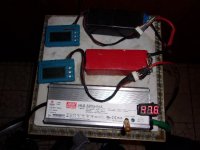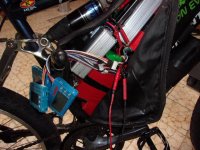Teslafly
10 mW
The time has come to build myself an Ebike.
With a monster hill on campus when I'm at school, a 4 mile commute to work during the summer (reasonably flat & bikeable, but leaves you fairly winded), and a slight amount of inspiration coming from the Moar kickstarter, the time has finally come to build myself an ebike where my current road bike is not cutting it anymore. (I should note, that I ride on campus year round, that means facing Wisconsin winters and all the fun that comes from icy hazards)
I have compiled a list of wants, and am currently looking at bits and pieces to get me there.
The two that are giving me the most trouble are the base bike, and to a lesser extent, the motor/controller.
Total budget: somewhere around $1200 max
Max speed: about 20-25mph, 1kw power level.
Rider weight: 180lb, probably 200lb with cargo.
Base bike frame:
Looking for a folding mountain bike with at least front suspension.
Budget: about $600, but flexible to reach a good frame. Less is better though.
Must:
- Brakes: ideally comes with disk brakes, but must have mounts for disk brakes, I am not opposed to installing later.
- Folding: Do not have to remove wheels to reach reasonable compactness.
Only has to fold so it can fit in my trunk/dorm room without hassle (my current bike needs both wheels
So a mid frame joint and releasable handlebars (so they flip 90 degrees to be parallel with the front wheel) would be optimal.
Want:
- Tires: would like to use 27.5+ sized tires (27.5 X 3.0) or (27.5 x 2.8), but recognize there may not be many good folding bikes that can support these wheels yet.
- Rear suspension: as someone who has never owned a bike with rear suspension, is this really necessary? How would a rear hub motor effect this? Especially with 27.5+ tires with more cushion?
Durability:
- Ride year round, in rain, snow, etc. (sidewalks/roads are cleared)
- Brakes / motor should handle a 1/4 mile long hill with [strike]30% grade[/strike]. Edit: I actually took a rough measurement, and it's more like a 10-15% grade at a bit over 5 degrees inclination.
Current options:
- Montague paratrooper: https://www.amazon.com/Montague-Paratrooper-Mountain-Safecastle-Stainless/dp/B01KYERXA6(wheels not + sized, expensive, handlebars don't release)
- http://usa.dahon.com/bikes/matrix/ (26" wheels, complex folding mechanism)
- https://www.amazon.com/Altruism-Bic...4396732&sr=8-8&keywords=folding+mountain+bike (good folding, small/weird wheels)
- https://www.aliexpress.com/item/20-26inch-folding-mountain-bike-21-speed-double-disc-brakes-bicycle-6-knife-wheel-and-3/32803888685.html?spm=2114.01010208.3.3.qYsvjT&ws_ab_test=searchweb0_0,searchweb201602_2...lgo_pvid=f6d7b619-375e-4f32-b599-57aa17d50ff2 (good folding, possibly low quality)
- Please suggest more
If a folding bike with 27.5+ wheels cannot be found, or even one with 26x3.0 wheels, that will be the requirement that is dropped.
Power system
- motor: ~1000w. Thinking rear hub motor.
○ Looking for suggestions on the motor / controller
○ Around $300 expected here
○ Have not put much effort into this so far as I don't have a selected frame.
○ Basically this: http://www.ebay.com/itm/48V1000W-26-Rear-Wheel-Electric-Bicycle-Motor-Kit-E-Bike-Cycling-Hub-Conversion-/231520160623?hash=item35e7ad4b6f:g:keUAAOSw4A5YrQJE
○ Not opposed to lacing on the rim myself if there are no motors that come ready for 27.5+ tires
- Battery: 12s/48v, ~16ah hobby battery. Thinking 2x 6s 16ah multistars if I can get them on sale. (around $90 each on sale)
○ Have similar battery on my power racing series cart.
○ Finally have a good test bed for my bms project. https://endless-sphere.com/forums/viewtopic.php?f=14&t=63863
- Monitoring:
○ Custom bms
○ Cycleanalyst / custom diy solution. - only really need battery level, current power, and speed
I have access to a makerspace with all the standards, mig/tig welding, 3d printer, laser cutter, etc. so I am capable of fabricating simple high cost/custom components.
So these are my design parameters. Are there bike frames or motor systems that would meet this?
Are any of my parameters a plainly bad idea or misguided?
With a monster hill on campus when I'm at school, a 4 mile commute to work during the summer (reasonably flat & bikeable, but leaves you fairly winded), and a slight amount of inspiration coming from the Moar kickstarter, the time has finally come to build myself an ebike where my current road bike is not cutting it anymore. (I should note, that I ride on campus year round, that means facing Wisconsin winters and all the fun that comes from icy hazards)
I have compiled a list of wants, and am currently looking at bits and pieces to get me there.
The two that are giving me the most trouble are the base bike, and to a lesser extent, the motor/controller.
Total budget: somewhere around $1200 max
Max speed: about 20-25mph, 1kw power level.
Rider weight: 180lb, probably 200lb with cargo.
Base bike frame:
Looking for a folding mountain bike with at least front suspension.
Budget: about $600, but flexible to reach a good frame. Less is better though.
Must:
- Brakes: ideally comes with disk brakes, but must have mounts for disk brakes, I am not opposed to installing later.
- Folding: Do not have to remove wheels to reach reasonable compactness.
Only has to fold so it can fit in my trunk/dorm room without hassle (my current bike needs both wheels
So a mid frame joint and releasable handlebars (so they flip 90 degrees to be parallel with the front wheel) would be optimal.
Want:
- Tires: would like to use 27.5+ sized tires (27.5 X 3.0) or (27.5 x 2.8), but recognize there may not be many good folding bikes that can support these wheels yet.
- Rear suspension: as someone who has never owned a bike with rear suspension, is this really necessary? How would a rear hub motor effect this? Especially with 27.5+ tires with more cushion?
Durability:
- Ride year round, in rain, snow, etc. (sidewalks/roads are cleared)
- Brakes / motor should handle a 1/4 mile long hill with [strike]30% grade[/strike]. Edit: I actually took a rough measurement, and it's more like a 10-15% grade at a bit over 5 degrees inclination.
Current options:
- Montague paratrooper: https://www.amazon.com/Montague-Paratrooper-Mountain-Safecastle-Stainless/dp/B01KYERXA6(wheels not + sized, expensive, handlebars don't release)
- http://usa.dahon.com/bikes/matrix/ (26" wheels, complex folding mechanism)
- https://www.amazon.com/Altruism-Bic...4396732&sr=8-8&keywords=folding+mountain+bike (good folding, small/weird wheels)
- https://www.aliexpress.com/item/20-26inch-folding-mountain-bike-21-speed-double-disc-brakes-bicycle-6-knife-wheel-and-3/32803888685.html?spm=2114.01010208.3.3.qYsvjT&ws_ab_test=searchweb0_0,searchweb201602_2...lgo_pvid=f6d7b619-375e-4f32-b599-57aa17d50ff2 (good folding, possibly low quality)
- Please suggest more
If a folding bike with 27.5+ wheels cannot be found, or even one with 26x3.0 wheels, that will be the requirement that is dropped.
Power system
- motor: ~1000w. Thinking rear hub motor.
○ Looking for suggestions on the motor / controller
○ Around $300 expected here
○ Have not put much effort into this so far as I don't have a selected frame.
○ Basically this: http://www.ebay.com/itm/48V1000W-26-Rear-Wheel-Electric-Bicycle-Motor-Kit-E-Bike-Cycling-Hub-Conversion-/231520160623?hash=item35e7ad4b6f:g:keUAAOSw4A5YrQJE
○ Not opposed to lacing on the rim myself if there are no motors that come ready for 27.5+ tires
- Battery: 12s/48v, ~16ah hobby battery. Thinking 2x 6s 16ah multistars if I can get them on sale. (around $90 each on sale)
○ Have similar battery on my power racing series cart.
○ Finally have a good test bed for my bms project. https://endless-sphere.com/forums/viewtopic.php?f=14&t=63863
- Monitoring:
○ Custom bms
○ Cycleanalyst / custom diy solution. - only really need battery level, current power, and speed
I have access to a makerspace with all the standards, mig/tig welding, 3d printer, laser cutter, etc. so I am capable of fabricating simple high cost/custom components.
So these are my design parameters. Are there bike frames or motor systems that would meet this?
Are any of my parameters a plainly bad idea or misguided?



